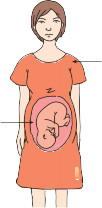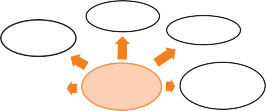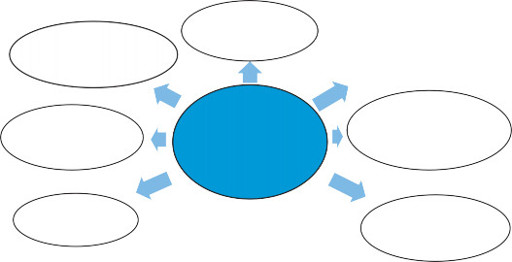Fundamentals of Midwifery: A Textbook for Students (106 page)
Read Fundamentals of Midwifery: A Textbook for Students Online
Authors: Louise Lewis

BOOK: Fundamentals of Midwifery: A Textbook for Students
4.62Mb size Format: txt, pdf, ePub
Receive healthy lifestyle information and referral
Confirm women are taking 5mg of folic acid daily
Advise to take 10mg of Vitamin D
Ensure VTE assessment has been undertaken in line with Maternity VTE guideline consider GTT pathway
Consider high risk factors
Consider prescribing aspirin
Receive healthy lifestyle information and referral
Confirm women are taking 5mg of folic acid daily
Advise to take 10mcg of Vitamin D
Ensure VTE assessment has been undertaken in line with Maternity VTE guideline consider GTT pathway
Consider high risk factors
Consider prescribing aspirin
Weigh at 36 weeks gestationUse large cuff to record BP. (record size of cuff used). Assess and document skin integrity at 36-38 weeks Ensure equipment appropriate in clinical areasDocumented assessment of pregnancy risks associated withobesity (please refer to 5.1)Weigh at 36 weeks gestationUse large cuff to record BP. (record size of cuff used). Assess and document skin integrity at 36-38 weeks Ensure equipment appropriate in clinical areasDocumented assessment of pregnancy risks associated withobesityA documented assessment will be evident from third trimester of pregnancy by a midwife, doctor or physiotherapist who have undertaken the trust’s moving and handling training to determine manual handling requirements for childbirth.Weight > 158 kg either at booking or 36 weeks inform Healthy lifestyle midwife or contact safety department for assessment of suitable equipment.A documented obstetric anaesthetic management plan for labour and delivery is discussed with the womanConsider tissue viability issues as advised from rust tissue viability service from and documenting management plan in maternity records. Explain increased risk and how can minimise risk.
Figure 11.11
Sample clinical pathway for weight management in pregnancy (courtesy of de Angelis and Robinson 2010 with permission).The Health Protection Agency (HPA) (2010) issues a list of communicable diseases; this varies between regions and at different times. Some childhood infectious diseases have re-emerged as serious public health threats. HPA (2013) reported an eight-fold increase in confirmed cases of whooping cough (caused by the
Bordatella pertussis
bacterium), when comparing the fourth quarter of 2011 with the same period in 2012 in England and Wales. This is transmitted by droplet spread, causing serious illness and mortality among very young children (Martin 2010). Because 429 confirmed diagnoses were among infants aged less than three months old the Chief Medical Officer announced that pregnant women would be offered vaccinations to protect their newborn babies (DH 2012). Vaccination ensures the development of maternal antibodies to the infectious agent, conferring passive immunity in young infants, until their vaccination between six and eight weeks after birth. Similar strategies occurred with such infectious disease as influenza virus H1N1 (swine flu) (RCM 2012). Midwives are therefore, directly involved in both protecting and promoting health in the area of infectious diseases.
Noxious substances (teratogens and toxins)
Noxious substances are those which are harmful or have extremely unpleasant effects (Soanes et al. 2005). In childbearing woman these substances may present harmful effects to both mother and baby. Teratogens are substances which induce the formation of developmental abnormali- ties in the fetus (teratogenesis): these may be medically prescribed or recreational drugs, legal or illicit substances. Some pathogens (disease causing agents) (e.g. rubella) and exposure to some therapeutic treatments (e.g. ionizing radiation) may also be teratogenic (Martin 2010). Teratogens may be environmental (e.g. contamination or pollution of air, food or water supplies). These substances cross the placenta and enter the fetal circulation (see Figure 11.12).
Medications
Medications women consume in pregnancy, for pre-existing chronic health conditions and preg- nancy induced health conditions (physical or psychological) may be teratogenic. Thalidomide and diethylstibestrol were prescribed to pregnant women, but were subsequently found to have caused fetal malformations (limb deformities) and the development of reproductive system malformations and cancers in women exposed in utero respectively (Lucchese et al. 2004).
 253Fetus
253Fetus
 Mother
Mother
Figure 11.12
Noxious substances, consumed by the mother, such as alcohol, may cross from the maternal to fetal circulation causing conditions like fetal alcohol syndrome.
Ammonia (NH
3
)
Nitric oxide (NO)

 Lead (Pb)
Lead (Pb)
Toxins
Nicotine
Carbon monoxide (CO)
Figure 11.13
Toxins found in cigarette smoke.254
 Anti-epileptic treatments such as (sodium valproate and carbamazepime) are associated with a higher risk of fetal anomalies such as neural tube defects and cardiac malformations. However, close consultation, cooperation and monitoring within the interdisciplinary team is required to manage these conditions in pregnancy, to ensure that women receive accurate, evidence-based care, including advice regarding lactation. NICE produce care pathways for the management of care of people with certain conditions. It is important to avoid the potential harms to both the mother and the baby of abrupt withdrawal from therapeutic medications due to fear of harm to the fetus.
Anti-epileptic treatments such as (sodium valproate and carbamazepime) are associated with a higher risk of fetal anomalies such as neural tube defects and cardiac malformations. However, close consultation, cooperation and monitoring within the interdisciplinary team is required to manage these conditions in pregnancy, to ensure that women receive accurate, evidence-based care, including advice regarding lactation. NICE produce care pathways for the management of care of people with certain conditions. It is important to avoid the potential harms to both the mother and the baby of abrupt withdrawal from therapeutic medications due to fear of harm to the fetus.
Cigarette and tobacco smoking in pregnancy
One quarter (26%) of mothers in the (UK) smoked at some point during pregnancy or in the previous 12 months (National Statistics and National Health Service Information Centre 2010); the highest prevalence was in Wales (33%), the lowest in England (26%): 54% gave up before birth. One eighth of all mothers (12%) smoked throughout their pregnancies. The overall preva- lence has continually decreased, between 2005 and 2010. Pregnant smokers inhale numerous toxins (see Figure 11.13) exposing the fetus, via the maternal-feto-placental circulation, to fetal serum nicotine concentrations 15% higher than those in the maternal serum (Huizink and Mulder 2005).Cigarette smoke impedes placental function, reducing uterine blood flow, causing fetal oxygen deprivation (fetal hypoxia-ischaemia) and malnutrition, resulting in intrauterine growth restriction (IUGR). Nicotine, carbon monoxide (CO) and tobacco tar can directly affect the fetal brain (Huizink and Mulder 2005; García-Algar 2008). Nicotine withdrawal has been noted in the early neonatal period (e.g. irritability, tremor and hypertonicity) and in childhood attention deficit hyperactivity disorder (ADHD) (Huizink and Mulder 2005; García-Algar 2008; Stroud et al. 2009). Furthermore, smoking increases risks of placental abruption, premature birth and sudden infant death syndrome (SIDS) (Hussein Rassool and Villar-Luís 2006).Research using biochemical markers of smoking in postnatal women has demonstrated sig- nificant underreporting of smoking in mothers who gave birth to growth restricted babies (Delpisheh et al. 2007); this suggests fear of disclosure among mothers who smoke. Midwives are often willing to engage with smoking cessation strategies with childbearing women; however they sometimes feel ill-informed and ill-equipped to broach the issue, without stigma- tising women and creating distrustful relationships (McLeod et al. 2003; Bull 2007). NICE (2010) and DH (2013b) recommend carbon monoxide breath tests to monitor women’s levels of inhaled cigarette smoke as a cost-effective, non-invasive biochemical marker which helps the clinician identify and explore exposure to cigarette smoke with all women, which may reduce the risk of stigmatising some. These tests may also indicate exposure to second-hand smoke and other environmental pollutants (Bailey 2013). NICE (2010) produced guidance aimed at supporting childbearing women to stop smoking in pregnancy or following birth.Cognitive developmental defectsBehavioural problems



Weigh at 36 weeks gestationUse large cuff to record BP. (record size of cuff used). Assess and document skin integrity at 36-38 weeks Ensure equipment appropriate in clinical areasDocumented assessment of pregnancy risks associated withobesity (please refer to 5.1)Weigh at 36 weeks gestationUse large cuff to record BP. (record size of cuff used). Assess and document skin integrity at 36-38 weeks Ensure equipment appropriate in clinical areasDocumented assessment of pregnancy risks associated withobesityA documented assessment will be evident from third trimester of pregnancy by a midwife, doctor or physiotherapist who have undertaken the trust’s moving and handling training to determine manual handling requirements for childbirth.Weight > 158 kg either at booking or 36 weeks inform Healthy lifestyle midwife or contact safety department for assessment of suitable equipment.A documented obstetric anaesthetic management plan for labour and delivery is discussed with the womanConsider tissue viability issues as advised from rust tissue viability service from and documenting management plan in maternity records. Explain increased risk and how can minimise risk.
Figure 11.11
Sample clinical pathway for weight management in pregnancy (courtesy of de Angelis and Robinson 2010 with permission).The Health Protection Agency (HPA) (2010) issues a list of communicable diseases; this varies between regions and at different times. Some childhood infectious diseases have re-emerged as serious public health threats. HPA (2013) reported an eight-fold increase in confirmed cases of whooping cough (caused by the
Bordatella pertussis
bacterium), when comparing the fourth quarter of 2011 with the same period in 2012 in England and Wales. This is transmitted by droplet spread, causing serious illness and mortality among very young children (Martin 2010). Because 429 confirmed diagnoses were among infants aged less than three months old the Chief Medical Officer announced that pregnant women would be offered vaccinations to protect their newborn babies (DH 2012). Vaccination ensures the development of maternal antibodies to the infectious agent, conferring passive immunity in young infants, until their vaccination between six and eight weeks after birth. Similar strategies occurred with such infectious disease as influenza virus H1N1 (swine flu) (RCM 2012). Midwives are therefore, directly involved in both protecting and promoting health in the area of infectious diseases.
Noxious substances (teratogens and toxins)
Noxious substances are those which are harmful or have extremely unpleasant effects (Soanes et al. 2005). In childbearing woman these substances may present harmful effects to both mother and baby. Teratogens are substances which induce the formation of developmental abnormali- ties in the fetus (teratogenesis): these may be medically prescribed or recreational drugs, legal or illicit substances. Some pathogens (disease causing agents) (e.g. rubella) and exposure to some therapeutic treatments (e.g. ionizing radiation) may also be teratogenic (Martin 2010). Teratogens may be environmental (e.g. contamination or pollution of air, food or water supplies). These substances cross the placenta and enter the fetal circulation (see Figure 11.12).
Medications
Medications women consume in pregnancy, for pre-existing chronic health conditions and preg- nancy induced health conditions (physical or psychological) may be teratogenic. Thalidomide and diethylstibestrol were prescribed to pregnant women, but were subsequently found to have caused fetal malformations (limb deformities) and the development of reproductive system malformations and cancers in women exposed in utero respectively (Lucchese et al. 2004).
 253Fetus
253Fetus Mother
MotherFigure 11.12
Noxious substances, consumed by the mother, such as alcohol, may cross from the maternal to fetal circulation causing conditions like fetal alcohol syndrome.
Ammonia (NH
3
)
Nitric oxide (NO)

 Lead (Pb)
Lead (Pb)Toxins
Nicotine
Carbon monoxide (CO)
Figure 11.13
Toxins found in cigarette smoke.254
 Anti-epileptic treatments such as (sodium valproate and carbamazepime) are associated with a higher risk of fetal anomalies such as neural tube defects and cardiac malformations. However, close consultation, cooperation and monitoring within the interdisciplinary team is required to manage these conditions in pregnancy, to ensure that women receive accurate, evidence-based care, including advice regarding lactation. NICE produce care pathways for the management of care of people with certain conditions. It is important to avoid the potential harms to both the mother and the baby of abrupt withdrawal from therapeutic medications due to fear of harm to the fetus.
Anti-epileptic treatments such as (sodium valproate and carbamazepime) are associated with a higher risk of fetal anomalies such as neural tube defects and cardiac malformations. However, close consultation, cooperation and monitoring within the interdisciplinary team is required to manage these conditions in pregnancy, to ensure that women receive accurate, evidence-based care, including advice regarding lactation. NICE produce care pathways for the management of care of people with certain conditions. It is important to avoid the potential harms to both the mother and the baby of abrupt withdrawal from therapeutic medications due to fear of harm to the fetus.Cigarette and tobacco smoking in pregnancy
One quarter (26%) of mothers in the (UK) smoked at some point during pregnancy or in the previous 12 months (National Statistics and National Health Service Information Centre 2010); the highest prevalence was in Wales (33%), the lowest in England (26%): 54% gave up before birth. One eighth of all mothers (12%) smoked throughout their pregnancies. The overall preva- lence has continually decreased, between 2005 and 2010. Pregnant smokers inhale numerous toxins (see Figure 11.13) exposing the fetus, via the maternal-feto-placental circulation, to fetal serum nicotine concentrations 15% higher than those in the maternal serum (Huizink and Mulder 2005).Cigarette smoke impedes placental function, reducing uterine blood flow, causing fetal oxygen deprivation (fetal hypoxia-ischaemia) and malnutrition, resulting in intrauterine growth restriction (IUGR). Nicotine, carbon monoxide (CO) and tobacco tar can directly affect the fetal brain (Huizink and Mulder 2005; García-Algar 2008). Nicotine withdrawal has been noted in the early neonatal period (e.g. irritability, tremor and hypertonicity) and in childhood attention deficit hyperactivity disorder (ADHD) (Huizink and Mulder 2005; García-Algar 2008; Stroud et al. 2009). Furthermore, smoking increases risks of placental abruption, premature birth and sudden infant death syndrome (SIDS) (Hussein Rassool and Villar-Luís 2006).Research using biochemical markers of smoking in postnatal women has demonstrated sig- nificant underreporting of smoking in mothers who gave birth to growth restricted babies (Delpisheh et al. 2007); this suggests fear of disclosure among mothers who smoke. Midwives are often willing to engage with smoking cessation strategies with childbearing women; however they sometimes feel ill-informed and ill-equipped to broach the issue, without stigma- tising women and creating distrustful relationships (McLeod et al. 2003; Bull 2007). NICE (2010) and DH (2013b) recommend carbon monoxide breath tests to monitor women’s levels of inhaled cigarette smoke as a cost-effective, non-invasive biochemical marker which helps the clinician identify and explore exposure to cigarette smoke with all women, which may reduce the risk of stigmatising some. These tests may also indicate exposure to second-hand smoke and other environmental pollutants (Bailey 2013). NICE (2010) produced guidance aimed at supporting childbearing women to stop smoking in pregnancy or following birth.Cognitive developmental defectsBehavioural problems



Other books
Final Sacrament (Clarenceux Trilogy) by Forrester, James
The Middle Age of Mrs Eliot by Angus Wilson
The Chosen Seed by Sarah Pinborough
And Now We Shall Do Manly Things by Craig Heimbuch
Wry Martinis by Christopher Buckley
The Unforgiven by Storm Savage
Waiting for Mr. Darcy by Chamein Canton
Evan Arden 02.5 Uncockblockable by Shay Savage
Back To The Divide by Elizabeth Kay
The Last Infidel by Spikes Donovan